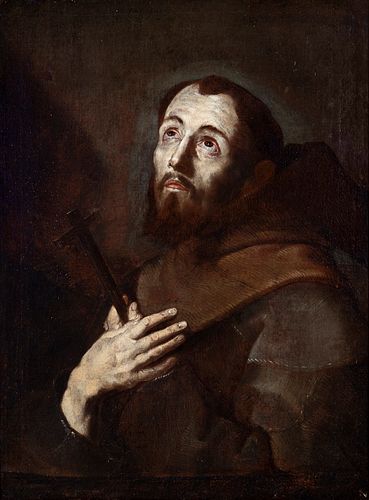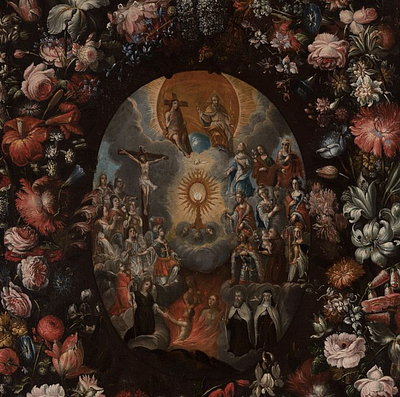Spanish school of the seventeenth century. Workshop of JOSÉ DE RIBERA (Xátiva, Valencia, 1591 - Naples, 1652). "St. Francis of Assisi". Oil on canvas.
Lot 123
About Seller
Setdart Auction House
Carrer Aragó 346
Barcelona
Spain
Setdart Subastas was born in 2004 and is currently the first online art auction in Spain with solidity, prestige and reliability guaranteed by our more than 60,000 users. Setdart has a young, dynamic and enterprising team ready to successfully manage the purchase and sale of art works through custom...Read more
Categories
Estimate:
EUR€18,000 - EUR€20,000
$19,354.84 - $21,505.38
Absentee vs Live bid
Two ways to bid:
- Leave a max absentee bid and the platform will bid on your behalf up to your maximum bid during the live auction.
- Bid live during the auction and your bids will be submitted real-time to the auctioneer.
Bid Increments
| Price | Bid Increment |
|---|---|
| EUR€0 | EUR€10 |
| EUR€200 | EUR€25 |
| EUR€500 | EUR€50 |
| EUR€1,000 | EUR€100 |
| EUR€3,000 | EUR€200 |
| EUR€5,000 | EUR€500 |
| EUR€10,000 | EUR€1,000 |
| EUR€20,000 | EUR€2,000 |
| EUR€50,000 | EUR€5,000 |
About Auction
By Setdart Auction House
Jul 14, 2021
Set Reminder
2021-07-14 06:30:00
2021-07-14 06:30:00
America/New_York
Bidsquare
Bidsquare : OLD MASTERS
https://www.bidsquare.com/auctions/setdart-auction-house/old-masters-7202
Setdart Auction House sofia@setdart.com
Setdart Auction House sofia@setdart.com
- Lot Description
Spanish school of the seventeenth century. Workshop of JOSÉ DE RIBERA (Xátiva, Valencia, 1591 - Naples, 1652). "St. Francis of Assisi". Oil on canvas. Re-drawn. Period frame. Size: 84,5 x 62 cm; 98 x 76 cm (frame). This remarkable representation of St. Francis in prayer is closely related to the San Francisco signed by José de Ribera belonging to the Masaveu collection, being also very close to the model preserved in the Sabatello collection in Rome, dated 1641, and considered work of the master's workshop. The success of the artist and the innumerable commissions he received, especially for these works of piety, justify the creation of an extensive workshop to satisfy the demand, a workshop that produced versions following the originals of the master who sometimes participated with his master brushstroke in these works, creating pieces made in collaboration between the artist and the workshop; this is what Professor Nicola Spinosa suggests must have happened in this canvas: given the quality of some details such as the tired and watery eyes or the nerves of the hands twitching on the chest, these must have been made by the master, finishing the composition with a brush from his workshop. The saint is depicted half-length, slightly tilted, with his hands crossed on his chest in a pious attitude, holding a crucifix. His gaze is raised towards the sky in an overwhelming attitude of spiritual recollection. The thick brushstroke defines a rotund figure, of profound humanity, with great economy of color, limited to the range of browns, which only emphasizes the message of humility and mystical simplicity that the saint advocated throughout his life. José de Ribera, known as the Españoleto, was a key master of the Spanish Baroque, and in general of the history of art in Europe. Although no documentary sources or evidence of his youth are preserved, it is believed that he trained with Francisco Ribalta in Valencia, after which he went to Italy, first to the north and later to Rome, where he learned first-hand about the classicists and the tenebrism of the Dutch who settled there. Finally he settled in Naples, where he arrived in 1616. Then began his period of maturity and splendor; Ribera enjoyed fame and a large workshop, and his works spread throughout Europe through engravings. He worked for viceroys and high officials of Spanish origin settled in Naples, so many of his works soon reached Spain. He was in fact famous in his native country, and in fact Velázquez himself visited him in 1630. Today works by Ribera are kept in the Prado Museum, the Louvre, the Capodimonte Museum, the Fine Arts Museum in Budapest, the Hermitage in St. Petersburg, the Kunsthistorisches and Liechtenstein Museums in Vienna, the J. Paul Getty Museum in Los Angeles, the Art Institute in Chicago, the Metropolitan Museum in New York, the National Gallery and the Royal Collection in London, the Borghese Gallery in Rome and other important art galleries in Europe, America and Asia.
- Shipping Info
-
In-house shipping available. Please inquire at admin@setdart.com.
-
- Buyer's Premium



 EUR
EUR CAD
CAD AUD
AUD GBP
GBP MXN
MXN HKD
HKD CNY
CNY MYR
MYR SEK
SEK SGD
SGD CHF
CHF THB
THB
















